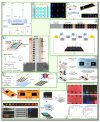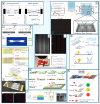Optical Image Sensors for Smart Analytical Chemiluminescence Biosensors
- PMID: 39329654
- PMCID: PMC11428294
- DOI: 10.3390/bioengineering11090912
Optical Image Sensors for Smart Analytical Chemiluminescence Biosensors
Abstract
Optical biosensors have emerged as a powerful tool in analytical biochemistry, offering high sensitivity and specificity in the detection of various biomolecules. This article explores the advancements in the integration of optical biosensors with microfluidic technologies, creating lab-on-a-chip (LOC) platforms that enable rapid, efficient, and miniaturized analysis at the point of need. These LOC platforms leverage optical phenomena such as chemiluminescence and electrochemiluminescence to achieve real-time detection and quantification of analytes, making them ideal for applications in medical diagnostics, environmental monitoring, and food safety. Various optical detectors used for detecting chemiluminescence are reviewed, including single-point detectors such as photomultiplier tubes (PMT) and avalanche photodiodes (APD), and pixelated detectors such as charge-coupled devices (CCD) and complementary metal-oxide-semiconductor (CMOS) sensors. A significant advancement discussed in this review is the integration of optical biosensors with pixelated image sensors, particularly CMOS image sensors. These sensors provide numerous advantages over traditional single-point detectors, including high-resolution imaging, spatially resolved measurements, and the ability to simultaneously detect multiple analytes. Their compact size, low power consumption, and cost-effectiveness further enhance their suitability for portable and point-of-care diagnostic devices. In the future, the integration of machine learning algorithms with these technologies promises to enhance data analysis and interpretation, driving the development of more sophisticated, efficient, and accessible diagnostic tools for diverse applications.
Keywords: biosensor; chemiluminescence; image sensors; machine learning; optical.
Conflict of interest statement
R.A., X.H., and S.W.-H. are co-founders of a 2023 McGill spinoff company, Phoela Health Inc.
Figures



Similar articles
-
Image stacking approach to increase sensitivity of fluorescence detection using a low cost complementary metal-oxide-semiconductor (CMOS) webcam.Sens Actuators B Chem. 2012;171-172:141-147. doi: 10.1016/j.snb.2012.02.003. Sens Actuators B Chem. 2012. PMID: 23990697 Free PMC article.
-
Complementary Metal-Oxide-Semiconductor-Based Magnetic and Optical Sensors for Life Science Applications.Sensors (Basel). 2024 Sep 27;24(19):6264. doi: 10.3390/s24196264. Sensors (Basel). 2024. PMID: 39409303 Free PMC article. Review.
-
Role of Machine Learning Assisted Biosensors in Point-of-Care-Testing For Clinical Decisions.ACS Sens. 2024 Sep 27;9(9):4495-4519. doi: 10.1021/acssensors.4c01582. Epub 2024 Aug 15. ACS Sens. 2024. PMID: 39145721 Free PMC article. Review.
-
Electrochemical and optical biosensors for the detection of E. Coli.Clin Chim Acta. 2025 Jan 15;565:119984. doi: 10.1016/j.cca.2024.119984. Epub 2024 Oct 12. Clin Chim Acta. 2025. PMID: 39401653 Review.
-
Surface-modified CMOS biosensors.Front Bioeng Biotechnol. 2024 Nov 6;12:1441430. doi: 10.3389/fbioe.2024.1441430. eCollection 2024. Front Bioeng Biotechnol. 2024. PMID: 39569164 Free PMC article. Review.
Cited by
-
Optical Detection Techniques for Biomedical Sensing: A Review of Printed Circuit Board (PCB)-Based Lab-on-Chip Systems.Micromachines (Basel). 2025 May 8;16(5):564. doi: 10.3390/mi16050564. Micromachines (Basel). 2025. PMID: 40428690 Free PMC article. Review.
-
Avalanche Multiplication in Two-Dimensional Layered Materials: Principles and Applications.Nanomaterials (Basel). 2025 Apr 22;15(9):636. doi: 10.3390/nano15090636. Nanomaterials (Basel). 2025. PMID: 40358253 Free PMC article. Review.
References
-
- Jiménez-Rodríguez M.G., Silva-Lance F., Parra-Arroyo L., Medina-Salazar D.A., Martínez-Ruiz M., Melchor-Martínez E.M., Martínez-Prado M.A., Iqbal H.M.N., Parra-Saldívar R., Barceló D., et al. Biosensors for the detection of disease outbreaks through wastewater-based epidemiology. Trends Anal. Chem. 2022;155:116585. doi: 10.1016/j.trac.2022.116585. - DOI - PMC - PubMed
Publication types
Grants and funding
LinkOut - more resources
Full Text Sources
Miscellaneous

